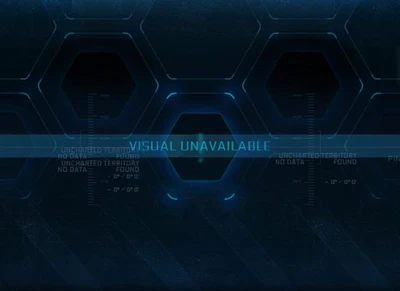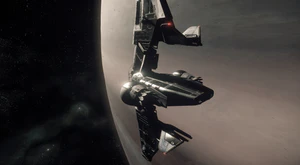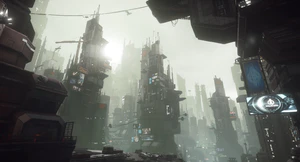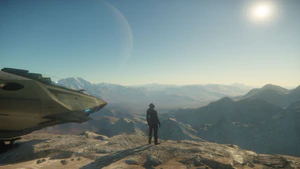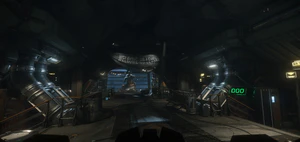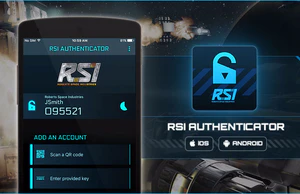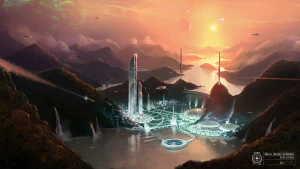Greetings Citizens.
We’re officially in the second half of 2016 now, and the already impressive progress on Star Citizen and Squadron 42 continues to speed up and cover more ground every month as more and more game systems, design systems, build systems and staff come online. For Star Citizen, a lot of this month focused on development for Alpha 2.5, 2.6 and even 2.7. For Gamescom and CitizenCon, work continues on demos that showcase systems coming online in those patches and beyond. For a better look at what that all entails, let’s dive right in.
CIG LOS ANGELES
Engineering
The engineering team have been helping stabilize SC Alpha 2.5.0 to ensure improved game play across several systems while continuing to chew away at the new ItemSystem. Almost all elements of our ships fall under this system, from seats to ladders to doors, etc. which makes it a major undertaking. We had David Bone Gill in from the UK because one of the many aspects of this new system is the interface and how that ties the whole experience together. His visit was incredibly bountiful and yielded many efficient solutions to how we’re going to make it all work nicely and we hope Bone comes back really soon.
Our own Senior Physics Engineer John Pritchett is hard at work on our Atmospheric Flight. This is quite an undertaking because everything that makes a ship fly from outer space to the surface of any planet has to be calculated precisely to give you the realistic feel of descending onto a new world while taking into consideration your ships specific flight mechanics.
Tech Design
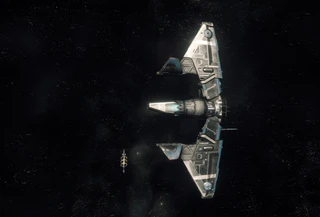
Tech Design has been working closely alongside John Pritchett, Chris Roberts, Todd Papy and others to make sure Atmospheric Flight is everything we expect it to be when the system is fully fleshed out in code. Thinking through this entire process is time consuming and incredibly exciting because of what it will unlock in our overall universe and game experience.
Calix Reneau worked alongside our global team ironing out the Salvage design further to be ready for code and implementation as well as several other design briefs. Meanwhile, Tech Designer Matt Sherman has been knocking out the tech setup and design of several ships currently in progress. The most obvious being the MISC Reliant Kore – Mini Hauler. He’s had several other ships he’s setting up alongside our art team that are very exciting with more information to come shortly.
Art
Character Artist Omar Aweidah has been working diligently on marine suits, getting them into a playable state alongside our tech content team and CG Supervisor Forrest Stephan. Associate Character Artist Cheyne Hessler has been actively working on all types of clothes for 2.5.0 including variants of all kinds. Senior Character Artist James Ku polished all types of different assets including the Male and Female base models.
The Drake Caterpillar is close to being finished on the art side. Lead 3D Artist Elwin Bachiller and his team are making major strides on that ship and are pushing to finish it to get ready for their next round of challenging ships.
Narrative
The Squadron 42 shoot is over and the Narrative team has finally been reunited in LA. As Chris mentioned on ATV a week or so ago, we ended up hitting around 1255 pages of scripts including wild lines, battle chatter etc., so yeah… that was a lot, but it was wonderful to be back on set with the awesome production team over there and the always amazing Imaginarium. It’ll be even better when we can actually talk about what we did over there.
In the final days of the shoot, however, we started to dip our toes in the vast ocean that will be the PU and recorded some sample lines for some generic and specific characters. Now that the PU is becoming more and more alive and more features are coming online, we’re going to start delving a little deeper into the narrative side, which is equally daunting and exciting.
Otherwise, the team’s been hard at work tackling the usual suspects (News Updates, Jump Point stories, Starmap) and we’ve had more time to spend on our Ask A Dev thread, so swing by if you’ve got questions that you think one of us could answer.
Quality Assurance
Los Angeles QA spent much of the month focusing on the new skeleton and recent animation changes, as well as preliminary testing for Item 2.0. We also got to check out early builds for the Dragonfly and for the atmospheric flight model which was very exciting in its own right as we take another step closer to the living universe everybody has been dreaming of. LAQA also helped in capturing in-game footage for a number of Community segments. Despite all of this, the team was still on hand to support development for the upcoming 2.5 release as well, with particular focus on the functionality and implementation of the new Grim HEX pirate station.
CIG AUSTIN
Development
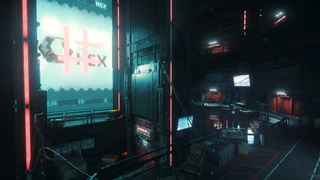
Our Design team, headed up by Lead Technical Designer Rob Reininger, have been focused on establishing various aspects of upcoming landing zones and points of interest. Most recently he and Jr. Technical Designer Robert Gaither have been supporting the LA Engineering team in setting up the new Item 2.0 elevators to work within Grim HEX Station. Before that, we established the inventories and whitebox setup for the new shops you’ll be able to find in the upcoming 2.5.0 release. Rob has also been further establishing the design for the Purchase Kiosk, an alternative way to shop for larger items that can’t easily fit into the physical shelves.
Designer Pete Mackay has been drafting up the GDD for Resource Spawning which will determine several methods of distributing resources throughout our play spaces. Separate approaches will be established for the procedural planet entities, one for asteroid fields, one for dust and gas nebula, and a final method for dealing with persistent/static entities or areas. Pete has been exploring aspects such as resource matter states, rarity, base value, and mass as well as locking down the general workflow for designers to setup the resource distribution.
Art/Animation
On the art side, Lighting Artist Emre Switzer has been iterating on feedback for final lighting passed on both Levski and Grim HEX. If you’ve seen any episodes of Around the Verse recently you’ve likely seen some of his work. Both environments are looking absolutely fantastic. Lead Ship Artist Chris Smith wrapped up his Final Art Pass on the Hornet F7A and has since moved on to revamping the Constellation variants to match the quality of the Andromeda. He’s currently focused on the Aquila and aims to have that wrapped up in the next few weeks. Ship Artist Josh Coons is still trucking along on the Drake Herald, working on the cockpit and ensuring it matches the metrics set forth by the Ship Animation Team.
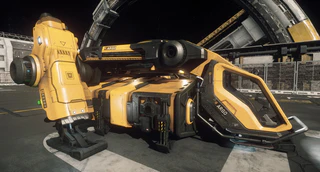
Speaking of Animation, our animators are hard at work on content for future releases. Ship Animator Daniel Craig worked to ensure that the Argo MPUV animation requirements complied with the ship geometry since the ship’s interior requires the character to crouch in certain situations. Lead Ship Animator Jay Brushwood has been knocking out animation requirements for the Drake Dragonfly, it’s a brand new type of vehicle, so it has been interesting to tackle the challenge it provides. Lastly, we wrapped up the reauthorized combat speed enter/exit animations for the Anvil Hornet and Super Hornet based off the data we got back from our mo-cap shoot at Imaginarium Studios. We’re turning our attention to reauthoring the M50 and Gladius next.
Our Persistent Universe Animation Team has been working diligently on polishing NPC animations for use in our peaceful NPC AI Subsumption system. Lead Animator Bryan Brewer has also been working with Design to solidify enter/exit metrics, creating helper files, and reviewing the female skeleton. On the engineering front, our Backend Services Team headed up by Lead Server Engineer Jason Ely has been focusing on new services for future releases. While Server Engineers Tom Sawyer and Ian Guthrie at Wyrmbyte spent the better part of half the month fixing up bugs related to the Persistence Cache and players being able to log in on multiple machines with the same account, Jason turned his attention to drafting up documentation for the Service Beacon, a new feature designed by Tony Zurovec. This new feature allows players to request immediate assistance in a number of different areas or, alternatively, to offer their goods and services to other players and NPCs.
QA
Austin QA has shifted the focus of the team back to our main development stream and are currently testing 2.5.0.
Multi-Factor authentication launched this month, with all the required testing and attention from the ATX QA team. This included testing all the app versions, new security features on the website and the updated launcher. Special kudos to Bryce, Scott, Brandon and Jeff for their devoted attention to supporting the deployment of Multi-Factor Authentication into the wild.
ATX and UK worked closely on weekly cross-studio play tests for performance and stability testing, but we also had a number of general destructive tests as nothing brings a group together like smashing space ships into each other. We also welcomed two new QA hires to our team this month – Elijah Montenegro and Tyler Tumlinson.
Game Support
Eric “Proxus” Green joined Chris Danks and Will Leverett to round out the current team. We went immediately to work on wrapping up 2.4.1, then began prep for 2.5.0 and beyond. Much of this involved training, documentation, processes… things that aren’t always sexy, but fundamental to running an online game.
Once done, we went straight to work with the Evocati on testing 2.5.0. We spent a lot of time shaping up how we process bug reports and feedback, revamping much of what existed. We’re very pleased at the quality of information that has come back to us in 2.5.0 testing, and we’ll be excited in getting the build out to a larger audience in the very near future. We’re actually looking at adding more Game Support Staff here in Austin, specifically an E-Commerce Specialist to help us investigate consumer behavior and traffic on the website, as well as to research and investigate outliers on the service. Feel free to give the position a look here and apply if you are qualified and interested.
IT/Operations
July marked another period of great progress on the Patch Size Reduction project. We’re now to the point of connecting programs together from the various teams and testing data delivery from point to point. This milestone is essential in getting us to the point of actually working with real data rather than just test data. Our own Mike “Sniper” Picket was seen in Austin segment of Around The Verse #100 modestly explaining his part of the project and what we’ve been working on.
The rest of the IT team has been working with Moritz out of our Frankfurt office supporting his preparations for the Gamescom event in Cologne, Germany. All demo equipment has to be assembled and tested with the latest game code on network gear exactly like what we expect to see on the ground at the show.
Many other side projects going on in the IT group this summer as well including a prototype build out of our new “Go Box”. Paul “Dr.” Vaden in the Austin studio is re-engineering the “office in a box” kit for size and efficiency. The goal of this project is to be able to plug in a ready-to-go infrastructure wherever we need it providing secure connectivity back home when on the road, say in Cologne. And our fearless leader Mike “Lagman” Jones has been counting bits again. He and Hassan in our UK studio have been working hard on designing a solution to increase performance and capacity of central storage systems in the UK and Frankfurt at a fraction of the cost.
LiveOps/DevOps
The team has been hard at work keeping track of a multitude of builds from multiple source streams with increased build replication and faster response times to build requests while simultaneously keeping up with internal tools development work. The Build system ran over 100 unique full testable builds moving well over a petabyte of data across the network resulting in around 75 internal server deployments.
Our Release Engineer, Miles continues to work with IT to find new ways of improving performance on incremental builds and asset compilations. Each 15-20 minute reduction may not seem like much, but when added together makes a huge difference in our major deployments. By breaking jobs down to smaller parts and cutting the time to rebuild, we can get more last minute fixes in to QA resulting in better builds out to the PTU publishes.
FOUNDRY 42 UK
Engineering
One of the main tasks of the company has been Subsumption and all of the systems which are tied into it, as it’s a core aspect of how we will create content and game play, specifically missions. This new mission system is designed to do away with the heavily-scripted Flow Graph and make it much more straightforward to implement the game play. For example, you can say that a particular area is going to be patrolled by a given group of ships and pilots and the Subsumption will do the rest: spawning them in when players arrive in the area and despawning them once everybody has left. Ultimately it will also allow the dynamic creation of missions in the PU, something we wouldn’t be able to do otherwise. This mission system is something that sits very closely to Subsumption and they both work very closely with each other.
Another area Subsumption will be driving is the AI and we’re helping move all the old behavior tree code over to use it. It’s never easy moving a system over and it does tend to mean you take a step backwards in functionality before you can start to move forwards but we’re now starting to get back to the position where we were and we can really see the progress it’s making.
Art
Lots of things to report, but you guys know that already. The biggest thing for me, even though it is starting off small, is that we are re-evaluating how we go about imagining the ship weapons. Historically we have been reactive in creating weapons (responding to requests from Design), so I’ve put a small hold on production until we, the concept team, can devise a more modular formulaic route so that we can quickly and easily create families of weapons. It’s basic stuff really, but you need time and headspace to be able to think things through for a longer term vision and we are now at that point thankfully. We wanted to put a system in place so the ship weapon artists can improve production and get more weapons out to the fans.
What else? Klaus and Werner ATT4 and Sniper are being given some extra love, working up the family and making them consistent and usable for Squadron 42, early work has taken place on Kastak Arms on the shotgun and again laying the groundwork for consistent styling.
Ships, well I’ve been working with Justin and we’ve taken care of some Caterpillar things, like color schemes and branding, also updating the F8 concept (it’s been 2 years since the first iteration) and managed to get a magazine cover knocked out too.
VFX
This month the VFX team have done a flight-ready VFX pass on the ARGO – thrusters, damage etc. Work also continued on the Grim HEX environment effects, taking full advantage of the new tiled lighting model. Work also continued on weapon impact effects improvements.
Aside from this, Mike visited Caleb in sunny Frankfurt – along with some of the UK environment and props team, to discuss VFX support for procedural planets. As you can imagine, there was LOTS to talk about – clouds, weather, water, atmospheric entry/exit to name but a few things we will need to support. Working out a long term plan for something as complex as a procedural planet is crucial; there is no sense in just throwing a load of effects in before we have worked out the systems with which to generate them.
Finally, our new VFX artist Michal jumped straight into ship effects, tidying up some of the existing thrusters (necessary with the move to optics flares and bloom in 2.5.0) and created some lovely new boost effects.
Environment Art
As ever, the team is focused on taking sections of their Squadron 42 levels and using them as visual targets for modelling, shading, lighting, dressing etc. We are also polishing what we are going to be showing at Gamescom this year, we’re excited for everyone to see what we’ve been working on. A small hit team of artists have just returned from spending two weeks in the Frankfurt studio where they focused on using the procedural tech and working with the engineers to push the feature along. Internally we’re all super excited for this, and it’s going to be big for creating environments for SC.
Animation
The animation team has been hard at work tackling a variety of issues, ranging from weapon reloading animations for all positions, fixing broken animations caused in the batch process, and iterating on the new character skinning and base pose. All their hard work has created a 1:1 match between Maya and the Engine.
Vehicle Art
This month, we knocked out the captain’s quarters and started mirroring areas to the other side of the ship (such as stairways, corridors, hallways) on the Idris. This next month we are aiming to have all the interior rooms on the Idris complete to final art with collision to allow for a full play through. We have been doing a lot of clean up on the Javelin: finishing off junction rooms and started moving over standardized areas we first created on the Idris (such as the captain’s quarters) and making it work for the Javelin, one of the benefits from building up our AEGIS building set.
The Bengal team have made great process too, we are wrapping up the final art of the exterior hull, completed the Gatling gun, AA turrets, exterior bridge. On the interior we are wrapping up some final touches on the main Hangar to ensure our shaders work well with our latest lighting pass and light linking tech. Interior bridge is also close to coming to completion, something we are very excited to show more of. The team has also started on both the ready room and bunk rooms.
Design
The Squadron 42 design pit have been hammering away at the levels and things are really coming together. Sometimes you think you know a level, you get used to seeing the same Grey-box and then we’ll get an art update and it’s a game changer. You can really soak up the scale and details, and gives you that extra push in morale. It’s one of the real joys of this job when a designer with a beaming smile calls you over with a “hey, check this out…”
Implementation of all the recorded performance capture dialogue is well under way now which is replacing any temporary designer dialogue and text-to-speech which must be a huge relief for the script writers Dave and Will. It makes you appreciate the actor’s craft in hearing Mark Hamill and co. deliver their lines in the game, it makes such a difference.
The Character team have really been delivering the goods recently, making some good inroads into the required costumes list so we’re getting to a point now in which we can start populating the levels with final characters in their correct costumes.
Props
The team has been fairly divided this month, all focusing on different areas of the game. Two of our guys have been working closely with the environment team to push the procedural planet tech, start devising workflows and nailing down the pipeline.
We have also refined the hanging clothing workflow which is a combined effort from the character team (who create the base items) and the props team (who transform them into hanging versions and eventually folded clothing). It may seem like a small fish, but it helps add realism and immersion to the shopping experience.
We continue to work on the ship items. We now have just over 100 ship items complete, so plenty of customization options will be available when the feature launches. Next, we’ll be looking into the ship interiors and how the sub items integrate into them. The newer members of the props team have all settled in great and with the new plethora of concepts coming everything is moving forward well.
Graphics
The graphics team has been split between new features for our expanded universe and low-level improvements to our shading model.
For the expanded universe, we’ve finally made the sun into an actual object that you can fly around. Previously in CryEngine, the Sun was always 10km away in an artist specified direction no matter where you were in the universe, but now it’s a hot glowing sphere that casts light and shadows in all directions as you would expect, and has a physically accurate reflection which grows as you get closer. We’ve also began work on our asteroid tech to place asteroid fields and planetary rings consisting of millions of asteroids with minimal artist setup.
On the shading side we’ve improved our specular reflection model based on recent research in the field, and this should give us brighter and more accurate reflections from lights as well as being cheaper (which was actually one of our main motivations for the change). We’ve also improved the physical accuracy of how rough or glossy materials look when you zoom in/out from them.
Our final improvement this month is that we’ve completed our changes to the exposure control system. We can now let the art team finely tune how bright or dark they want the scene to appear, allowing them to use a much higher dynamic range of lighting. We’ve also implemented a realistic adaption algorithm that individually adjust according to your pupil dilation and photo pigment adaption.
Audio
Sam Hall fixed up some audio functionality in the editor, provided a host of new hooks for the dynamic music system and has been working on bug fix support for the 2.5 release.
Graham Phillipson has also been bug-fixing specifically: working on what we’re calling ‘interiority’ (so that we can change sounds depending on the player’s perspective/relationship to inside/outside sound sources more efficiently), RTPC normalization for consistent reverb levels across environments, further VOIP code tidy-up, adding pitch control to AudioAreaAmbiences and adjusting to his role in leading up the audio programming team.
Darren Lambourne has been hammering away at the Dragonfly and generally polishing up and improving ship audio, with the Idris taking up a fair chunk of time too. While Stefan Rutherford has been continuing work on the GrimHex map, providing support for new systems (elevators, doors etc.) and continuing revising and improving upon the FPS module audio.
Ross Tregenza has been coordinating with composers Pedro Camacho and Geoff Zanelli to get music into the game for both the Persistent Universe and Squadron 42. There’s a been a huge amount of work on the music logic system with some great new code aspects added by Sam Hall. He’s been iterating and tweaking the system and assembling the content in Wwise and finessing it all into one big seamless system.
Simon Price has been continuing his work on the dialogue pipeline, as well as providing support for bug-fixing too. Meanwhile, Bob Rissolo and Phil Smallwood were both out on patrol duties at the Squadron 42 shoot in Ealing and are dealing with the subsequent editorial work currently.
Matteo Cerquone has been working on some Squadron 42 maps, adding states and similar game-syncs; worked on UI “purchase Items” sounds; tested new ship engineRTPCs and assisted with some new parameters for improved ship audio feedback. Matteo’s also been working with Luke Hatton to prototype the new UI ship sound design language to have consistency over the different manufacturers, and divide the UI information into different pools of sounds.
Ewan Brown has made improvements to the spaceship flight audio feedback system. This translates more of the ship’s physics into usable audio parameters. Now speed and acceleration, in both linear and angular axes, are being fed into the audio engine. He’s also been working on new audio controls for atmospheric wind and turbulence and systems to improve dialogue lip sync for upcoming cinematic scenes. Meanwhile, Jason Cobb has been setting up mix states for GrimHex, building pipeline support and refined the ATL generation script. That’s in addition to general bug testing and smashing.
QA
The Foundry 42 QA team worked very hard with the Dev team again and of course, the community, to get 2.4.0 out to you guys and it was really rewarding. The response we got was amazing, but we didn’t stop there. After pushing it out, we gathered up all your feedback and bug reports and went straight in to get 2.4.1 out for you. After 2.4.1, some of the team cycled right into 2.5.0, while the rest started working on some lovely things to show at Gamescom.
This month was also good for seeing our team grow, with three new starters each starting a week apart, Ian Goodey, Stephen Austin & Idreece Hadi, they have fit well into the team and already have started focusing on specific aspects of testing, with Ian looking at Squadron 42 and FPS, Stephen working heavily on the Gamescom stuff and Idreece taking a technical testing approach.
FOUNDRY 42 DE
Engine
The Frankfurt core team working on planets is fairly small, Marco Corbetta & Carsten Wenzel working on the main tech and Pascal Mueller on environment art, but recently a couple of new people have been added. Anis Hireche is working on the ocean and effects, as well as Sascha Hoba working on PlanED, the planetary/ecosystem editor embedded into Sandbox. In addition to the above team, Mikhail Korotyev has been helping a lot with all round physics and math support.
Our next steps on the planets are going to be focused towards improving visuals even more, making the planets more and more interactive with landing areas and ecosystems. This includes numerous things such as massive rendering of objects, which is efficiently supported by the Zone system, worked on mainly by Chris Bolte, and prototyping the different planet types that make up the core Star Citizen universe. With the shift towards ecosystems we are putting more and more planets in the control of the artists which so we can create an interesting and engaging universe with deep history.
On the Zone system side, there has been a large refactoring and optimization pass on the tag system, plus several engine optimizations and fixes for 2.5 release, with more progress and features planned for the coming months. Additionally, Chris Raine has been working on a new local physics grid and planetary grid system.
We also continued working on vision stabilization for the first person view (1P). This is necessary to counter the head-bob that results from sharing the same rig between 1P and third person (3P) modes (meaning, essentially, that instead of being a floating camera, your character’s body and its movements are treated the same way as all the other characters you see.)
To achieve this we’ve developed several techniques that effectively simulate how human eyes stabilize an image. The first deals with the eyes directly and eliminates all orientation changes from the body on the camera, which is most effective when the body is idle. The processes mirrors how human eyes stabilize an image on the retina. The second, head stabilization, which we patterned after how birds deal with this same problem, keeps your head at a fixed position by counter-translating body motions to maintain the perception of stability. The adjustments are only a couple of centimeters at a time, which are barely visible on 3P models. The end result of a great tool for designers and animators that allow them to tweak the amount of head-bob to a level most people perceive as realistic. This is an ongoing development process and there will be more tweaks and improvements in the coming month.
The core engine team also focused on the Tag System. The Tag System allows us to mark up certain objects with Tags to give them a Semantic, for example Tagging an entity as a “stool” allows the code to determine if it is a stool (and potentially can be used to sit on it). We changed the architecture to store the data in Dataforge instead of a custom xml based database. In addition, we generalized the whole system so that we can store the Tags in the Zone System. This allows us to perform efficient spatial queries on all entities in the universe searching for specific tags.
Design
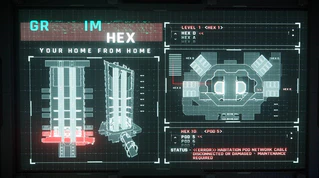
On the system design side, we’ve started work on the AI Crew Skills & Stats system which governs how good an AI is at doing a specific job and how players can improve their AI Crew at fulfilling specific tasks. In general, no two AI should be the same. Some will be better at shooting, tactics, or special weapon use while others might be better as an engineer or a tactical officer on your ship. The idea is to get players to carefully choose their crew, train them in order to improve specific qualities and take care of them, making sure they don’t die or get injured during operations.
All our social systems are seeing major reworks as we are pushing hard towards getting friends/contact lists, groups and organizations implemented properly in game. This should allow easier management of all social functions without having to quit the game while at the same time being fully integrated with the Spectrum ecosystem for players that want the social interaction but cannot afford to open the game on a phone or on a work computer.
A lot of work is going into most of our access systems, from Doors, Airlocks, Elevators and making sure these systems are integrated with all other systems in a station or ship like security, docking, customs etc. New tech has also come online allowing us to break down bigger systems into their component parts and link them together with signal links which get synced over the network. For example, a door can be just that but if we add a security terminal to it that will control access to the door and only allow people with the exact security clearance to pass through it.
The Level Design team is continuing its work on locations for the PU, we’ve just finished up Grim HEX which will give the less law-abiding players a location to use as well as providing a setting where shadier deals can take place. We will continue to expand upon Grim HEX, adding in more content and new sections to fully flesh out the location. Levski is progressing nicely as well, roads and access points have been added to the exterior, so visitors can reach the location both from the surface as well as from space.
We are also doing R&D regarding modularity and location components, this involves developing a system, as well as tools, that we can use to build everything from satellites to planetary outposts whilst maintaining the quality, realism and visual standards that we have set for Star Citizen. The system will provide us with the speed and flexibility we need to build the many locations required to bring our universe to life.
Weapons
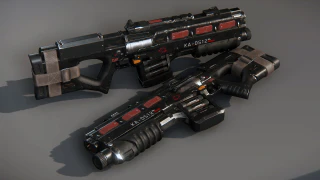
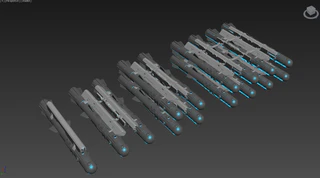
Last month we focused on finishing up the Behring P8-SC SMG as shown recently on ATV and giving the older weapons some texture polish as well. We have also brought them in line with our updated manufacturer style guides so some of the color schemes have slightly changes. Here’s a screenshot of the updated Devastator 12.
On top of that we have started to look into blocking out new and modular Missile Rack systems. These are supposed to bring our Missiles to sensible sizes, aid with balance and provide players with a lot more options in terms of what can be equipped on their ships.
Quality Assurance
DEQA has been very busy with testing updates involving both Physics and Rendering. These changes will enable our Engineers to implement future features much more seamlessly, as well as decrease performance issues in the client. Multiple test requests also came down the pipeline from our Cinematics team, post mo-cap shoot in London.
Together with Hannes Appell and Michael Nagasaka we were able to identify, repro, and JIRA TrackView issues that were encountered in the Editor during the shoot. The fixes for these issues will further improve our cinematic tools, which will be a huge benefit for the Cinematics team in future shoots.
AI
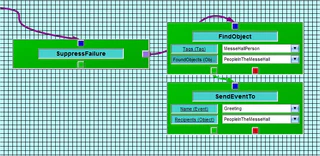
During July the AI team has primarily been focusing on Subsumption and the mission system.
First of all, we are now at version 0.962i for the Subsumption Editor, it is now much more stable and the usability has improved a lot.
We also introduced the possibility of defining the type of outputs a Task has, for example a SuppressFailure node only has a “Success” output while, for example. FindObject or SendEventTo have both a Success and Fail outputs. This allows us to properly inform the designers to what they should expect and handle from each task they can use in their behaviors.
The new mission system has also received a lot of attention in July, we created all the basic elements that will allow us to create and maintain a huge amount of missions for Squadron 42 and Star Citizen in general. Since the new mission system is embedded into the Subsumption tool, it allows designer to create their mission’s logic inside callbacks sent by the game when specific events occur. Imagine you need to escort a specific character to a safe location. If the character dies it calls a specific callback in the mission system and the designers can specify some specific logic that should be executed at that moment. We’ll show you more about this in the coming months.
We also worked on the Usables, improving the way NPCs can interact with multi IPs usable objects: you can think about a couch with three slots, when a character is tired and want to sit, he doesn’t care which slot to use but any free place is good to sit down. We also started the work on the perception of large objects, so that our NPC will be able to look at spaceships from distance and also look at big objects that might be occluded by other large elements (skyscrapers, mountains, and so on)
For the spaceships we worked on some fixes to allow the AI to land on specific landing pads correctly and we moved the crew definitions for specific spaceships into Dataforge so that tech designers can easily use our internal tool to customize the different ships. And of course, in addition to the development of new features we also continued on improving the stability of the overall AI system and fixed as many bugs as we could.
BHVR
Engineering
This month we focused mostly on bug fixing. Some of the fixed issues included: purchasing errors (weapons with attachments weren’t given to the player, server/client crashing after transactions, etc.), drop down options not being displayed correctly in the Option Screen, and various AR bugs.
We also worked on cleaning up our low level UI data binding framework and added multiple features to give more control to the design team.
The Tag System is also coming back on our priority list now that more core features (such as AI) want to make use of tagging. Tags are an efficient way to add metadata to entities in the world enabling all sorts of features for design and engineering alike.
Design
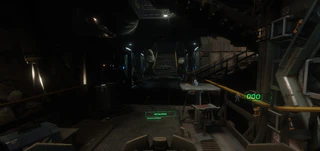
We spent most of this month finishing, polishing and debugging of the abandoned imperial asteroid base we mentioned last month. There were assets missing, visibility area and export issues, gravity problems, some weird collisions, etc. Those are all common issues coming with a new release, and we’re on top of it.
We also continued integrating flair items into the game for future releases and worked on upcoming shop whiteboxes.
Art
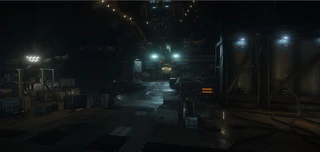
More polish, bug fixing and optimizing was done with the help of our design team on Grim HEX and abandoned imperial asteroid base. Continuing the theme of storytelling, we wanted to make sure the visuals from the high level of a planet down to the details of a room reflects the passage of time from its dwellers. Given the size of the Star Citizen Universe, expect a significant contrast in visual style between the two locations.
TURBULENT
Multi-Factor Authentication (MFA)
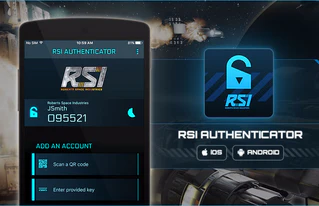
Last month, we launched Two-Step Authentication. Although it is optional, we strongly recommend that you enable it on your RSI account.
Two-Step Authentication adds an extra layer of security to the login process. In addition to your username and password, you would need to enter a special code in order to access your account. You can choose to receive this code by email, or via the mobile app (available for iOS and Android).
This was one of the most requested features from the community, so we’re really excited about this launch. For more detailed instructions and download links, please check out our page :
https://robertsspaceindustries.com/comm-link/transmission/15414-Two-Step-Authentication-Has-Landed
Communication Platform
For those of you who follow this column regularly, you’ll know that we have been working on a new communication platform that includes a new Forum and Chat module. We continue to work on the design and development of this platform, but at the same time, we are looking toward the “Phase 2” feature set which will offer additional communication channels. It’s still too early to present a defined list of features, but we are targeting CitizenCon to demo the “Phase 1” version. It’s only two months away, so you won’t have to wait much longer.
Game Launcher
We continue to develop the new game launcher, and we are working closely with CIG’s dev team on this project. We are targeting CitizenCon to have something that we can demo. Although the user interface will look the same, the “guts” of the launcher will be completely revamped and will allow the launcher to support multiple games and environments in the future.
COMMUNITY
Day-to-Day
As many of you may already know, our fearless leader Ben Lesnick spent much of the month in hospital fighting a severe infection, but we’re happy to report he’s back to Bendancing in the office now. He and Alexis are incredibly grateful for the love and support you guys shared during their difficult time on the forums and through social media.
Much of the day-to-day this month outside of that was spent coordinating and realizing the changes to our broadcast output, which we’ll go into greater detail in the next section, suffice to say that we couldn’t be prouder of the people here who pulled all the extra hours to make rotating the shows through the studios possible. Shout-outs to Thomas Hennessy, Justin Chambers, Tyler Witkin, Eric Davis, Sandi Gardiner, Jake Ross, Brian Chambers, Tom Solaru and a host of others for their continuing efforts to make that possible.
In addition to that, the road to Gamescom is always one of the most intense periods of the year. Our five days of gameplay streaming LIVE from that showfloor next month and the prep for our Fourth-Annual Gamescom Party and Presentation have dominated much of our day-to-day. I cannot understate how excited I am to meet so many of you in person, to play with so many of you over five-days of livestream, and celebrate Star Citizen together over the Gamescom week.
Broadcasts
Our most visible change this month was the newly updated format for Around the Verse. The team took a look at how to improve the show and then developed a plan to both update the format and to share more content from our studios around the world. We’ve been thrilled with the reaction, and can’t wait for you to see what’s coming up in future shows. Finally, a special thank you is owed to our Subscribers, who provided extensive feedback to assist with the update through the Subscriber’s Den forum.
The Loremakers Guide to the Galaxy has joined Bugsmashers in the Wednesday broadcast window. We’re incredibly happy to give the community a chance to hear about the lore, science, and design of the star systems that make up the universe of Star Citizen and Squadron 42 directly from the folks creating it.
You Guys
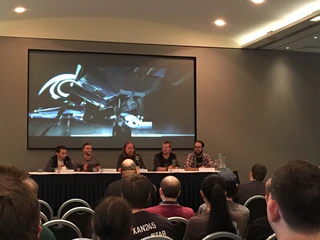
As another month of development passes, so does another month of stories, content videos, and community accomplishments.
On the streaming side of things, we were very excited to see the new podcast “Diverse the Verse” starring Sofiegrl, MzHartz, Lady Nighthawk, PixelMeSane, and Witchkittie. Keep these coming, we love hearing what our backers have to say.
We also announced that Star Citizen streamers Deejay Knight, Captain_Richard, BadNewsBaron, and Twerk17 will be traveling with us to stream live from the showfloor at Gamescom 2016.
On the Community Hub front, the amount of activity continues to amaze us. July saw new content coming from SCLoreCast, created by Lord Bayne, which breathes life into Star Citizen lore by adding music, sound effects, and epic voice-acting. Hasgaha lived up to all expectations with his continuous flow of beautiful Star Citizen screenshots, this time creating PSA Big Bennys addiction posters.
Speaking of Big Bennys, the long awaited Ballad of Big Bennys was released thanks to the help from all of you who submitted game-play clips, and of course the always-amazing years1hundred for editing it all together.
Lastly, how could we not give a shout-out for the first and potentially annual 2016 BritizenCon. This event is a fan-organised convention in the UK for Star Citizen fans to come together, hang out with developers, and talk shop.
I could keep listing the awesome content coming from all of you for days, but instead check it out for yourself on our “Community Hub”
Thank you all for making July one to remember. We can’t wait to see what you all come up with in the month of August…
THE WRAP-UP
Looking Ahead
What. A. Month. It’s full steam ahead towards Gamescom 2016 and then CitizenCon 2016 in the weeks after that, and everyone here is brimming with excitement to share even MORE of what we’ve been working on at those two events. It’s an amazing time to be a Star Citizen, and witness the unparalleled look behind-the-scenes at the making of the Best Damn Space Sim Ever, every week, every month, and beyond.
We’ll see you at Gamescom 2016; we’ll be the ones on the Idris bridge.
